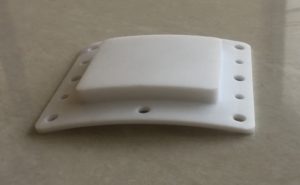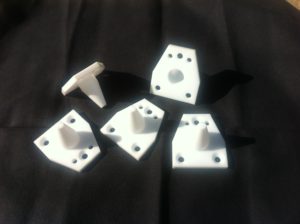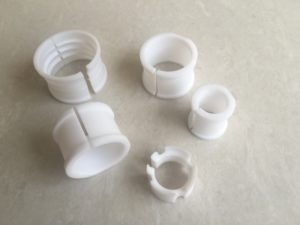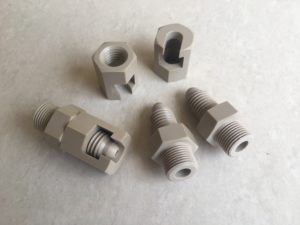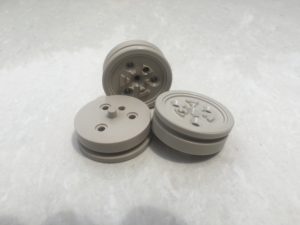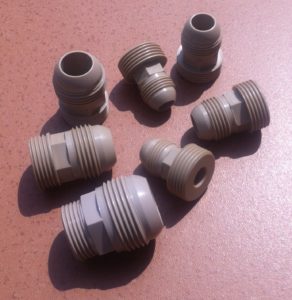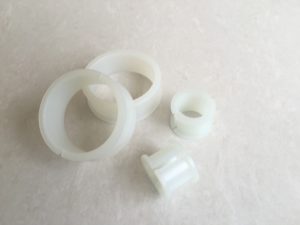PTFE is known to be among the most chemically resistant materials known to man. While this property is well known and often quoted in manuals and our own blog articles, we would like to touch upon some of the common applications that this property leads to.
PTFE Labwares
PTFE has been a mainstay in lab-ware items for a number of years. Lab-ware items include stopcocks, beakers, pipes, test tubes, stirrers, petri dishes and stands. In most labs, glass is the commonly used material for these items, but as we know, glass has a tendency to break. Furthermore, when dealing with harsh chemicals at elevated temperatures and pressures, PTFE becomes a viable option for a number of reasons.
- PTFE is chemically inert – barring certain alkalis at elevated temperatures
- PTFE does not break easily: Under loads, virgin PTFE would tend to deform rather than break. This makes it useful in applications involving high centrifugal forces – where a glass test tube might break under extreme loads
- PTFE is stable across temperature fluctuations: Even toughened glass would have a limit on how suddenly it can be cooled down when under high temperatures. PTFE is able to cool down rapidly from elevated temperatures without cracking
- PTFE is a great sealing material: Especially for stopcocks, PTFE forms a much better seal than glass equipment owing to the fact that it is soft and will easily seal gaps which may arise due to minor variations in taper between the pipe and the stopcock.
- PTFE is flexible: PTFE tube can be used in place of glass and be bent to accommodate the layout of the apparatus
- PTFE can be moulded with a magnetic core: PTFE stirrers are used because they can be moulded with a magnet at the core and used in magnetic mixers
Stirrers and shafts are used primarily in highly corrosive applications including biotech, pharma and refineries. The ability of the PTFE to be constantly immersed in a chemical and neither modify nor be modified by the chemical makes it an invaluable component in many mixing arrangement.
More often than not, the shaft or stirrer needs to be custom moulded and machined to suit the mixing assembly. This makes it an expensive component and therefore only sparingly used. In some cases, a stainless steel core can be used over which the PTFE is moulded/ lined. In other cases, the stainless steel shaft can simply be coated with PTFE. However, this latter case only works where there is little or no abrasion expected on the shaft – since PTFE coating will peel off if the shaft is subjected to wear.
Although the name sounds strange – the umbilical cord is a well-known arrangement of PTFE tubes used in the refinery industry. The purpose is simple – the refinery process yields a number of different gasses, which need to be analysed in a lab to gauge whether the right chemical reactions are taking place in the chamber. Taking these gasses to the lab (which needs to be a minimum of 200-250 meters from the reaction chamber) is a difficult process, as the gasses are corrosive and highly reactive – which may mean that they change composition during transit if not kept in a chemically inert environment.
An assembly of 12-15 tubes is bunched together using a PVC coating and each tube has a length of 250 meters and transports a single gas to the lab, where it is collected and analysed.
The complication in this design is that the PTFE tube needs to be continuous for the entire length of 250 meters. Any bonding or jointing leads to a foreign chemical in the tube and this affects the gas passing through it. After extensive trials, we find that using a welded joint comprised of PTFE is able to create an effective solution for the tubes.
Many chemical applications involve multiple substances, which often need to be separated from one another. In such cases, PTFE becomes the preferred medium for filtration.
PTFE is used in 2 forms here:
- Porous PTFE sheet: This is a standard PTFE sheet skived from a porous PTFE billet. The billet is made porous by adding certain substances in the PTFE compound, which sublimate during the sinter cycle, leaving voids. These voids form the pores which aid in filtration. This type of membrane is not used extensively due to the inexact nature of the pores. However, the membrane can be made as thick as 5mm – which makes it useful in corrosive applications where a liquid needs to be separated from large solid particles.
- Expanded PTFE membrane: This is also called breathable PTFE membrane owing to the fact that you can pass gas through it, but not liquids. Expanded PTFE is more commonly used that porous PTFE as the pore size can be easily defined to within a few microns. It finds multiple applications in automotives, pharma and biotech.
PTFE Valves and Ball Valve Seats
Although valves and ball valves form an industry unto themselves and use a variety of materials other than PTFE, certain applications involving the flow of chemicals need PTFE valves to withstand the corrosion otherwise caused to non-PTFE valves.
Our own experience with PTFE valves sees it being used in piping systems in chemical plants and in equipments such as paint dispersion machines.
In paint dispersion, the equipment is used by retailers to mix different colours of paint to form a batch of a new colour as chosen by the customer. The paint passing through the PTFE valve needs to remain un-changed. Any reaction due to, say, using a nylon or PVC valve can alter the colour to the extent that the colour being chosen by the customer does not match the actual colour of the final paint. Thus PTFE is an invaluable component within this assembly.
Reprocessed PTFE and chemical applications
We had earlier done an article on reprocessed PTFE and the various issues it presents with regards to the base properties of the material. One of the issues we have observed is that when using reprocessed PTFE, the scrap is seen to change colour when using a coolant during machining. This came as a huge shock to us – as common opinion suggests that it is only in mechanical properties that the material suffers when reprocessed.
The finding leads us to believe that a number of things may be happening to cause this:
- There may be foreign substances used in making the reprocessed PTFE. Titanium Di-Oxide for example is a known additive in making PTFE appear whiter. Similarly – cheaper, un-tested additives may be added to improve appearance, which may not have the chemical inertness that PTFE has.
- Micro-impurities may be present in the material that cannot be seen by the naked eye. These may be reacting with the coolant causing the colour change
- The basic chemical structure may be altered on a microscopic level. PTFE is chemically inert because of its molecular structure, which involves a carbon atom, shielded by 2 atoms of fluorine. When we chemically etch PTFE, we effectively remove 1 flourine atom and expose the carbon atom, making it bondable. A similar transformation may be happening in parts of the material due to reprocessing – which cause a degradation in the chemical resistance of the material.

